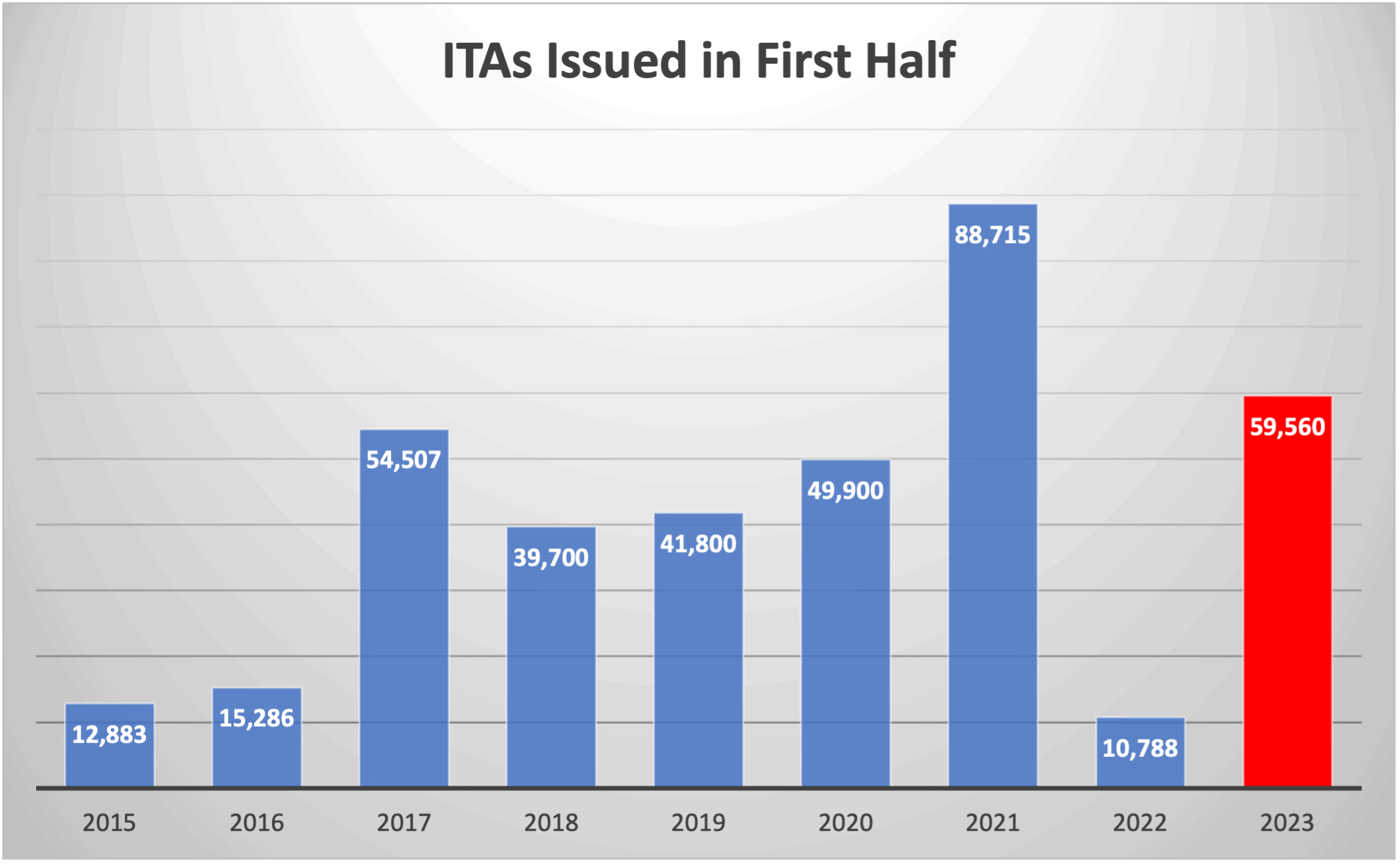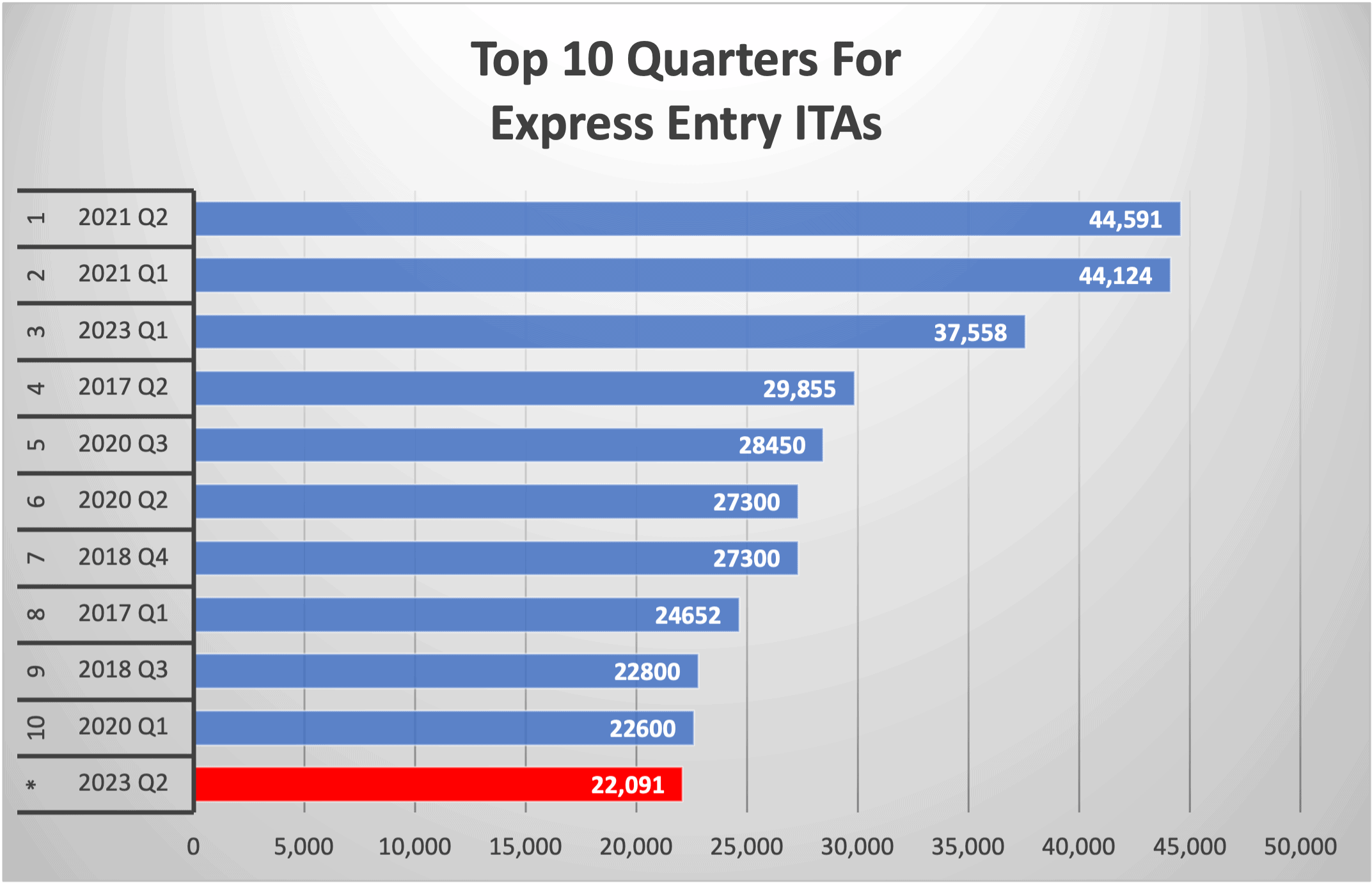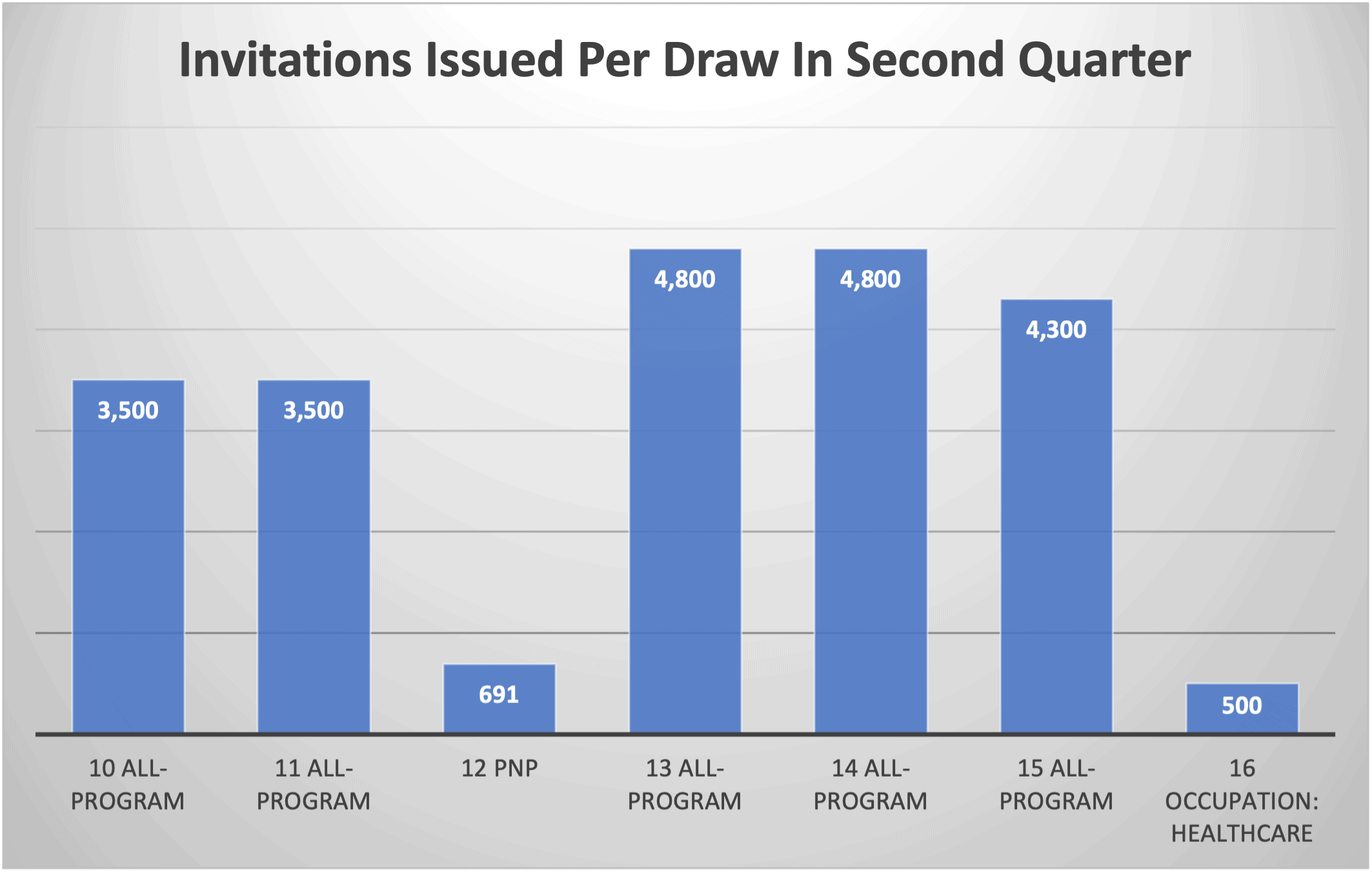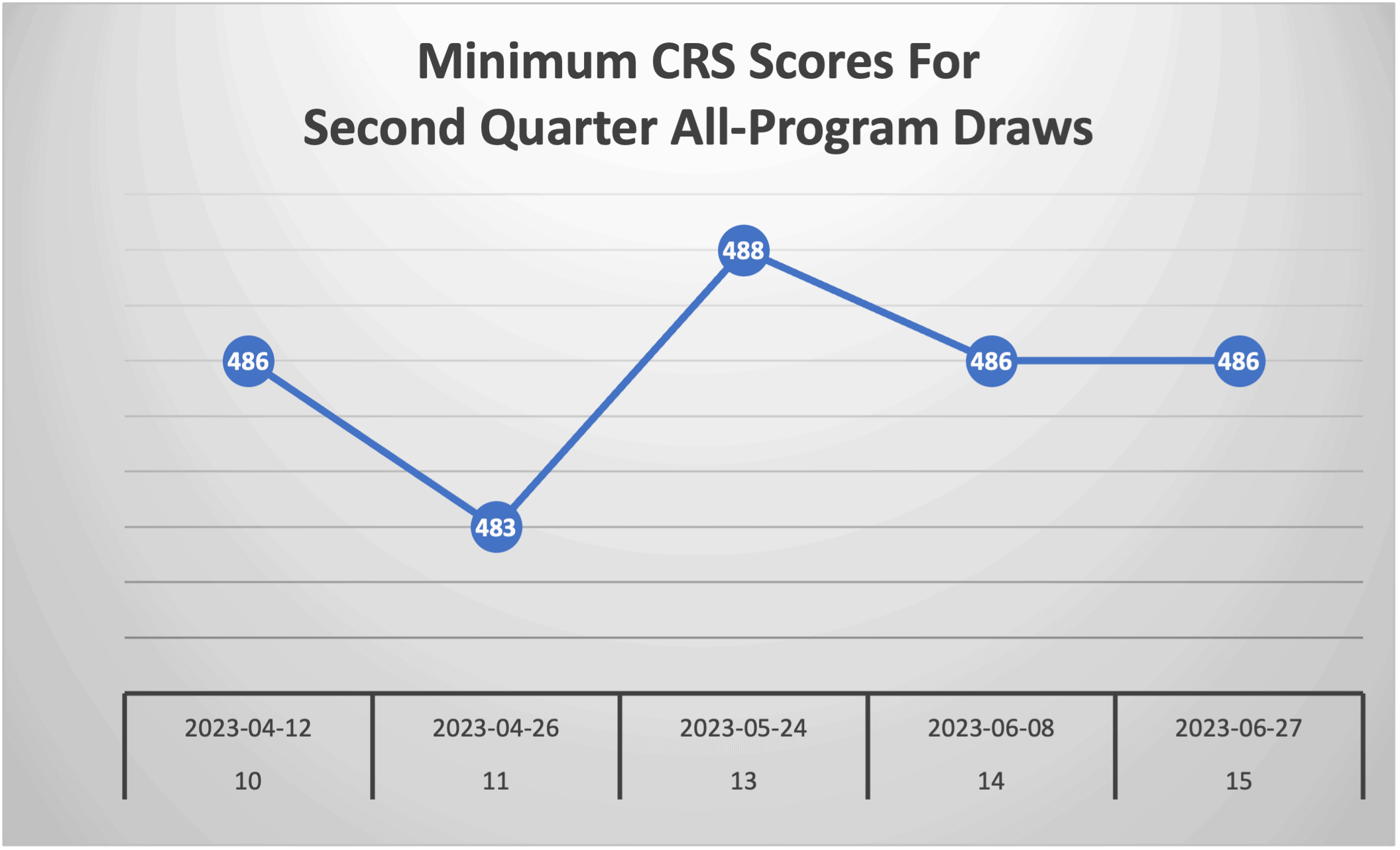The second quarter of 2023 was historic for Canada Express Entry, featuring the first occupation-specific draw in its history.
The 500 Invitations to Apply (ITAs) issued to healthcare candidates on June 28 marked a move into a new era for the immigration selection system, with the ability to better respond to labour market shortages.
But aside from the move to occupation-specific draws, the second quarter and first half of 2023 were significant for other reasons.
The more than 22,000 ITAs issued between April and June brought the six-month total to nearly 60,000, making it the second most prolific first half on record for the system.
Only the first half of 2021, when Immigration, Refugees and Citizenship Canada (IRCC) conducted its mega draw featuring more than 20,000 invitations, saw more ITA issued that the most recent six months.
What is Express Entry?
Express Entry is an immigration system implemented by Canadian immigration authorities (IRCC) on January 1, 2015 which manages skilled worker applications under Federal Economic programs. This includes the Federal Skilled Worker Program, the Federal Skilled Trades Program the Canada Experience Class and parts of the Provincial Nomination Programs.
The numbers paint a picture of a thriving Express Entry system, with Canada planning to welcome a record 465,000 new immigrants in 2023, including 82,880 through the Federal High Skilled stream.
Occupation-Specific Draws Have Arrived
It may have been a small draw of just 500 ITAs, but the healthcare-targeted invitations of June 28 represent a seismic shift in the direction of Express Entry.
At the end of May, Immigration Minister Sean Fraser announced draws would start, targeting 82 occupations in five categories, as well as francophone candidates.
Those five categories are:
- healthcare
- science, technology, engineering, and mathematics (STEM) professions
- trades, such as carpenters, plumbers and contractors
- transport
- agriculture and agri-food
Fraser was clear that these fields were only for 2023, meaning others could be added, or some taken away, next year and beyond.
It means Express Entry can now feature three different kinds of draw, namely general, or all-program, program-specific, targeting one of the four programs that fall under the selection system, or the new occupation-specific category.
Fraser has already flagged that the next healthcare draw will see 1,500 candidates invited on July 5 and the first STEM draw will take place in the same week. This is the first time an immigration minister has pre-announced Express Entry draws.

Aside from the buzz around new occupation-specific draws, the second quarter and first half were both strong ones for Express Entry.
In five all-program, one PNP and one occupation-specific draw, Canada invited 22,091 candidates in the second quarter, bringing the first-half total to 59,560, the second-highest on record.
IRCC is aware that invitation numbers must be high to meet its 2023 immigration target of 465,000 new immigrants, which rises to 485,000 in 2024. Many of the candidates invited this year will not arrive until next year, if their applications are successful.
Watch
Read More
Canada Invites Healthcare Workers In First Occupation-Specific Express Entry draw
Why Canada Express Entry Occupation-Specific Draws Will Lead To Lower CRS Scores
Every One Of The 82 Jobs To Be Targeted In Canada Express Entry Occupation Draws
Truck Drivers To Be Targeted In Canada’s New Express Entry Occupation Draws
Canada Express Entry Draws To Target 82 Occupations In 5 Fields Starting In Summer 2023
Canada Passes 50,000 Express Entry Invitations For 2023 With New All-Program draw
The invitations issued in the second quarter were not quite enough to break into the top 10 quarters for Express Entry.
While the first quarter saw the third-highest number of ITAs issued, the second quarter was just outside the top 10, as indicated in the table below.
As immigration levels continue to rise, it is likely that future Express Entry quarters will break into this top 10.

Individual draw sizes were also lower in the second quarter.
An important difference between the first and second quarters is that those invited between January and March are likely to arrive in the same calendar year.
This means IRCC officials knew they were inviting candidates in the first quarter who would be their new immigrant arrivals target for 2023. Those invited in the second quarter are more likely to arrive in 2024.

The average size of an all-program draw for the second quarter was 4,180 ITAs, compared to an average of 6,400 invitations in the first quarter.
Both quarters featured five all-program draws.
One of the features of the second quarter was that minimum Comprehensive Ranking System scores changed very little.
Three of the five draws saw minimum CRS scores of 486, with one of 483 and the other of 488. This gives candidates a clear picture of where their scores need to be to qualify for an all-program draw.
The gaps between draws continued to play an important part in terms of CRS score. When Canada sticks to all program draws every two weeks, scores generally drop slightly with each draw. In the second quarter, it was more erratic with its gaps between draws. That, and the fact that draw sizes were smaller, meant that CRS scores were maintained during the month.
It is anticipated that scores will be lower for occupation-specific draws in future. This was true of the first healthcare draw, which saw a minimum CRS of 476.

Express Entry in the Rest of 2023
In the rest of 2023, stakeholders will be on the lookout for more occupation-specific draws and the impact they will have on the Express Entry system.
We already know that healthcare and STEM draws are coming on July 5. The minimum CRS scores for those draws will be revealing, given the expectation that occupation-specific draws are likely to have a lower minimum score than all-program draws.
The way in which Canada mixes up its draws will also be something to look out for.
With a third category of the draw now available to IRCC, officials now need to gauge how often they need to conduct all-program draws to ensure enough candidates are being invited to meet immigration targets.
With the majority of the 82 occupations included in the occupation-specific draws falling in the healthcare and STEM categories, draws in the other three categories are likely to be smaller, given they are targeted at fewer jobs.
It can be said with some clarity that IRCC will need to issue a high number of draws in the rest of the year in order to meet immigration targets. What it now must decide is the mix of categories in which it will issue those invitations.